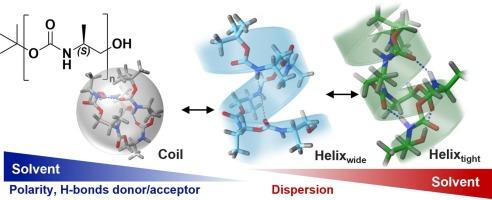Solvent effect on secondary structures of discrete, isotactic, oligourethane motif – towards engineering protein-like features in abiotic polymers
IF 6.3
2区 化学
Q1 POLYMER SCIENCE
引用次数: 0
Abstract
Sequence-defined and stereocontrolled polymers offer a platform for engineering synthetic macromolecules that can mimic the structural sophistication and folding behavior of natural proteins. Among them, oligourethanes represent a promising class due to their synthetic accessibility, tunable stereochemistry, and potential for intramolecular hydrogen bonding. Here, we report a comprehensive study of solvent-dependent folding of the isotactic oligourethane backbone, revealing how medium polarity and hydrogen-bonding interactions dictate the formation and stability of defined secondary structures. Using a combined approach of molecular dynamics and NMR spectroscopy, we identified two distinct helical motifs: the compact, hydrogen-bond-rich 2.614 helix and the less stable, solvent-exposed 422 helix. Our findings demonstrate that nonpolar aprotic environments uniquely stabilize the 2.614 helix, while polar and protic solvents disrupt its hydrogen-bonding network. This work highlights the critical role of the environment in shaping the conformational landscape of abiotic polyurethanes. It provides fundamental knowledge for designing protein-mimicking materials that could perform under non-physiological conditions.

溶剂对离散、等规、低聚聚氨酯基序二级结构的影响——面向非生物聚合物中工程蛋白样特征
序列定义和立体控制聚合物为工程合成大分子提供了一个平台,可以模仿天然蛋白质的结构复杂性和折叠行为。其中,低聚氨基甲酸酯因其易于合成、立体化学可调和分子内氢键的潜力而成为一种很有前途的化合物。在这里,我们报告了一项对等规低聚聚氨酯主链的溶剂依赖性折叠的全面研究,揭示了中等极性和氢键相互作用如何决定定义的二级结构的形成和稳定性。利用分子动力学和核磁共振光谱相结合的方法,我们确定了两个不同的螺旋基元:紧凑的,氢键丰富的2.614螺旋和不太稳定的,溶剂暴露的422螺旋。我们的研究结果表明,非极性非质子环境独特地稳定了2.614螺旋,而极性和质子溶剂破坏了其氢键网络。这项工作强调了环境在塑造非生物聚氨酯构象景观中的关键作用。它为设计可以在非生理条件下工作的蛋白质模拟材料提供了基础知识。
本文章由计算机程序翻译,如有差异,请以英文原文为准。
求助全文
约1分钟内获得全文
求助全文
来源期刊

European Polymer Journal
化学-高分子科学
CiteScore
9.90
自引率
10.00%
发文量
691
审稿时长
23 days
期刊介绍:
European Polymer Journal is dedicated to publishing work on fundamental and applied polymer chemistry and macromolecular materials. The journal covers all aspects of polymer synthesis, including polymerization mechanisms and chemical functional transformations, with a focus on novel polymers and the relationships between molecular structure and polymer properties. In addition, we welcome submissions on bio-based or renewable polymers, stimuli-responsive systems and polymer bio-hybrids. European Polymer Journal also publishes research on the biomedical application of polymers, including drug delivery and regenerative medicine. The main scope is covered but not limited to the following core research areas:
Polymer synthesis and functionalization
• Novel synthetic routes for polymerization, functional modification, controlled/living polymerization and precision polymers.
Stimuli-responsive polymers
• Including shape memory and self-healing polymers.
Supramolecular polymers and self-assembly
• Molecular recognition and higher order polymer structures.
Renewable and sustainable polymers
• Bio-based, biodegradable and anti-microbial polymers and polymeric bio-nanocomposites.
Polymers at interfaces and surfaces
• Chemistry and engineering of surfaces with biological relevance, including patterning, antifouling polymers and polymers for membrane applications.
Biomedical applications and nanomedicine
• Polymers for regenerative medicine, drug delivery molecular release and gene therapy
The scope of European Polymer Journal no longer includes Polymer Physics.
 求助内容:
求助内容: 应助结果提醒方式:
应助结果提醒方式:


